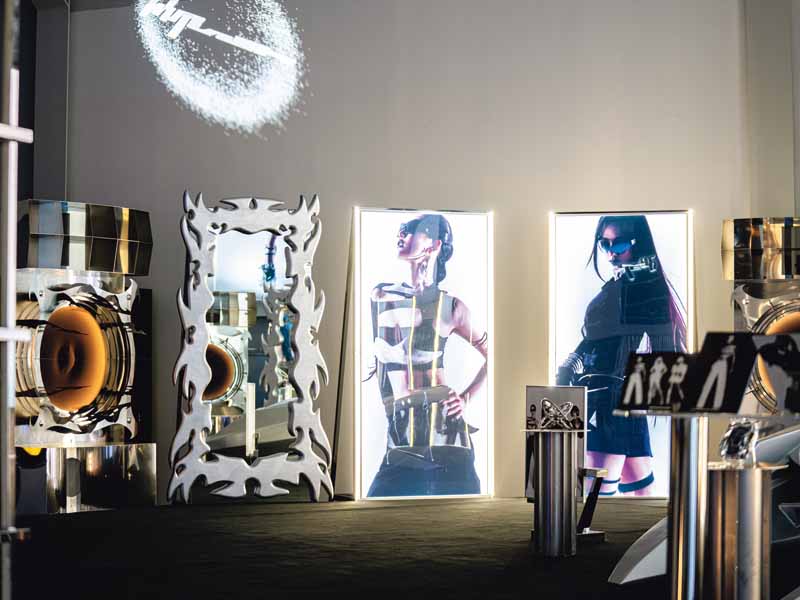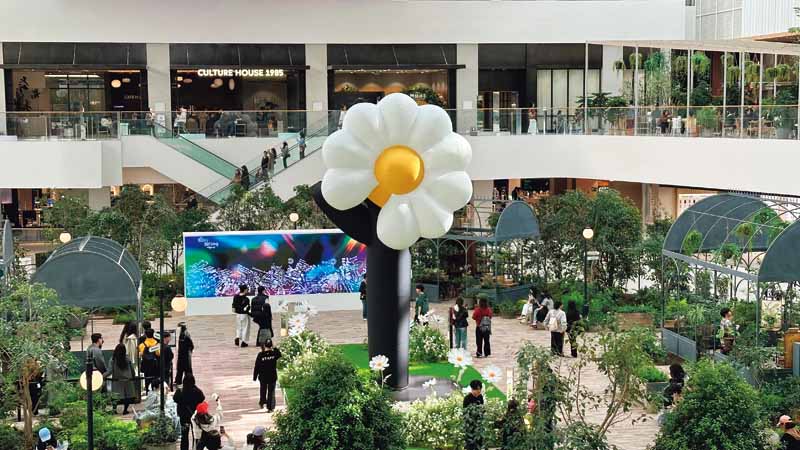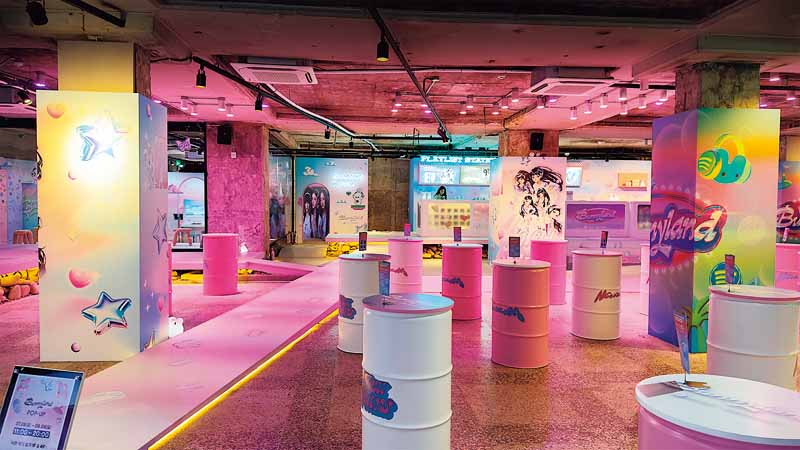Pop-up stores are so successful in promoting K-pop artists that they’re carving out a niche of their own. Once simple outlets for promoting new albums, they have evolved into brand-collaborative experiences and storytelling vehicles that bring an artist’s world to life, expanding their attraction beyond fandoms.

æspa WEEK – #Whiplash_mood was a pop-up store celebrating the release of Whiplash, æspa’s 5th mini album. The K-pop group’s segyegwan (“concept universe”) and album theme were reimagined through kinetic art, with the entire space transformed into a multisensory experience for fans. It was held in Seongsu-dong, Seoul, from late October to early November 2024.
Courtesy of SM Entertainment Co., Ltd.
The K-pop scene now feels incomplete without pop-up stores. This shift happened in just four or five years, and at some point, they simply became the norm. Having demonstrated remarkable synergy with commercial brands, the short-term retail spaces emerged as the perfect marketing solution during the COVID-19 pandemic. In those days defined by social distancing, they bridged the divide between K-pop stars and their fans. Since the end of the pandemic, they have become a staple of the K-pop ecosystem, energizing the industry, driving business expansion, and diversifying revenue streams. Their novelty aligns with K-pop’s instinctive openness to new trends, and sometimes fans consider a well-crafted pop-up store even more significant than a song release or music video.
STABILITY AND BELONGING
During the pandemic, pop-up stores offered fans the comforting sense that they were still connected. While pop-up stores generally focus on promoting a product to the widest possible audience and attracting new customers, the K-pop variety focuses on engagement with an established fandom. Pop-ups promoting the release of a new album aim to deepen fans’ connection to the content and foster a strong sense of belonging and immersion in an atmosphere akin to that of fan-organized events celebrating a favorite musician’s birthday or anniversary. In short, K-pop pop-up stores are the most advanced form of immersive, hands-on fan activity.
Such interaction with an already dedicated fandom is even more striking when compared to traditional major in-person events such as concerts and fan signings, which can’t happen without the presence of the artist. This is rare in an industry where intellectual property — an artist’s influence and creative assets — is traditionally the principal growth driver. In the K-pop universe, most of the pop-up stores’ revenue isn’t from music but from merchandise.

G-DRAGON Media Exhibition: Übermensch, held at The Hyundai Seoul in March 2025, celebrated the release of G-Dragon’s third full-length album Übermensch. While incorporating technologies such as VR, AI-driven voice interaction, holograms, and a massive media façade, the exhibition also featured daisy installations, emblematic of G-Dragon, placed throughout the venue to create a cohesive design.
© Shutterstock
THE BEGINNING
Given K-pop’s long history of spawning businesses around its powerful intellectual property, it’s not easy to say when the first K-pop pop-up store opened. Still, if the stores are defined as physical spaces where fans can explore creative content without the artist being present, 2015 is a good starting point. That year, the girl group f(x) released its fourth studio album, 4 Walls, at Drawing Blind, an exhibition venue in Seoul’s Itaewon neighborhood. At the time, pairing K-pop with an exhibition was a novel idea.
Before the album’s release, teaser photos and videos were projected across all four walls and even onto the ceiling, transforming the gallery into an immersive spectacle that drew widespread attention. Blending K-pop’s signature teaser promotions with an exhibition format, the event foreshadowed the pop-up stores that have since grown into large-scale productions.
At the time, Min Hee-jin directed f(x)’s visuals. Later, she developed the girl group NewJeans, who became central to establishing a new blueprint for K-pop in the 2020s, including runaway success through pop-up store brand collaborations. In August 2022, NewJeans’ debut pop-up at a sleek shopping center, The Hyundai Seoul, marked what’s now considered the opening salvo in the still ongoing boom in K-pop pop-ups. Massive lines formed at the event, which featured fashion-forward designs and layouts that broke the mold for selling merchandise, attracting broad attention across the music industry and among fandoms.
NewJeans has since kept the momentum alive with inventive brand collaborations that surprised at every turn, from the dessert brand NUDAKE to the animated series The Powerpuff Girls. The pop-up store promoting their 2023 EP, Get Up, attracted around 100,000 visitors.
THE POP-UP REDEFINED
Pop-ups that once relied on a display of photos or merchandise sales have long since lost their appeal, and a much broader range of creative approaches is now being explored. One standout example is Where is KEY? with HELLO KITTY, a recent collaboration between SM Entertainment and Sanrio Korea. At its center is BOK-SILLee a mischievous character created by Key from SHINee, that crosses paths with Sanrio’s Hello Kitty in a space that unfolds like a whimsical fairy tale. Seamlessly blending 2D and 3D content, the pop-up store was an impressively polished and delightfully quirky event.

Bunnyland, a pop-up celebrating the release of NewJeans’ 2nd mini album, Get Up, was a collaboration with global music streaming platform Spotify and digital IP platform company IPX. From July to late August 2023, it appeared in various spots across Seoul, drawing big crowds with its immersive space and interactive content. The photo shows an experience space installed at the Nakwon Musical Instrument Arcade.
Courtesy of Artpoint
Animated by the surging pop-up craze, entertainment companies big and small have eagerly joined the rush. They are constantly testing and stretching the formula for success.
Pop-ups that once relied on a display of photos or merchandise sales have long since lost their appeal, and a much broader range of creative approaches is now being explored. One standout example is Where is KEY? with HELLO KITTY, a recent collaboration between SM Entertainment and Sanrio Korea. At its center is BOK-SILLee a mischievous character created by Key from SHINee, that crosses paths with Sanrio’s Hello Kitty in a space that unfolds like a whimsical fairy tale. Seamlessly blending 2D and 3D content, the pop-up store was an impressively polished and delightfully quirky event.
But that’s not all. The pop-up stores are now expanding beyond physical spaces — and even beyond dimensions. SEVENTEEN’s 2023 main in-person event, SEVENTEEN STREET, took the form of a sprawling, open-air pop-up that broke free from the confines of indoor venues to incorporate locations like Sebitseom, artificial islands in the Han River, and trendy districts such as Seongsu-dong and Apgujeong.
In the first half of 2025, PLAVE celebrated their second anniversary with a pop-up store called Happy Plave Day, fully embracing the group’s identity as virtual idols. The event was a creative way to connect the digital stars and their fans, who could never really meet them in person. Commemorative leaflets, handwritten letters from the members, a celebratory cake based on their drawings, and a live photo zone using proprietary technology that let fans pose “with” their idols — every detail was carefully orchestrated to make visitors momentarily forget that these virtual stars and their audience exist in different dimensions.
The essence of a K-pop pop-up is exactly that — togetherness. In a fleeting, almost mirage-like space and moment in time, fans interact with artists and other fans, deepening the sense that we are one. Visitors leave with the belief that they are part of a single team moving toward a common goal. Through this intangible bond and yet tangible embodiment of community, the very meaning of pop-up is being redefined.